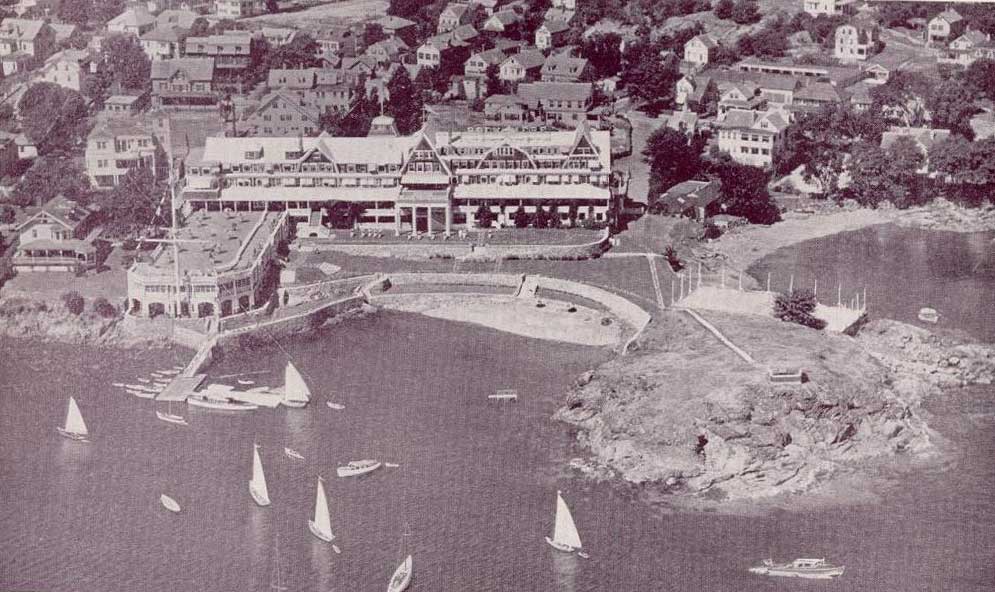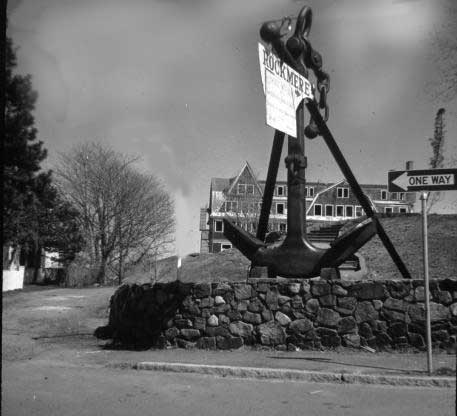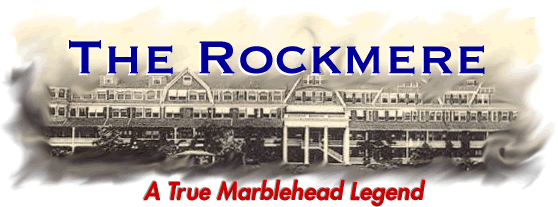One of the most vibrant periods
in Marblehead history was when she hoisted the flag on of the premier
resort hotels on the eastern seaboard, the unforgettable Rockmere Hotel.
With 94 rooms, a private beachfront,
and a commanding view of the harbor, not many hotels of the day could
rival her. From 1901
thru to the late 1950's The Rockmere hotel and Fo'Cas'Le restaurant provided
dignitaries, visitors and locals with world-class accommodations, dining
and entertainment. The Rockmere hotel, also known as The Rock-Mere hotel,
was a prime example of the resort style hotel that was popular in the
first part of the 20th century.
Today, modern vacationers look for short,
action-filled vacations. But in days gone by, the upper-middle class
family would vacation, usually for the whole summer, at a resort. Many
of these resorts included: modern amenities (by the standards of
the day), refined dining,
superior, personalized service, and entertainment in a luxurious
environment. All of these resort requirements were met and exceeded in
The Rockmere hotel.
Gilbert & Hattie
Brackett moved to Marblehead after selling their Dry Goods shop in Boston.
They purchased the bluff and beachfront property that would become the
future site of the hotel from a family member named Giles Brackett. Hattie
had spent her youth summering in the Berkshire Hills with her family,
so the idea of building a resort hotel was a natural transition for
her husband and her since they had taken in seasonal boarders their first
few
years in Marblehead to help pay expenses. With the decision to build
a hotel
made
and with the unique ocean front land purchased, construction began on
a hotel which overlooked the harbor on
the curve of Skinner's Head. This was made possible because of a loan
from a family acquaintance in Boston. All of the photos and postcards
that
detail the life of the hotel show that the main building of the hotel
kept it's original facade through the years of operation, but there
were additions to it like the Fo'Cas'Le restaurant expansion
and a gazebo down by the water. Also, there were original buildings
on the property that were used by the owners and staff as residence.
The buildings were known as East View, Gate Cliff and Dovecote. Over
the years they were all either removed or demolished.
 The
Rockmere hotel grew and prospered in the years immediately after initial
construction. Researching
the visitors and dignitaries who passed through the hotel reveals that
one of the most notable groups that stayed at the hotel was
Alpha Delta Pi,
the firstnational fraternal society for college women. This group held
their 1923 annual convention at the hotel. It is also well documented
that
President
Coolidge
was in the habit of mooring his yacht, the Mayflower, in the harbor while
staying at The Rockmere. The
Rockmere hotel grew and prospered in the years immediately after initial
construction. Researching
the visitors and dignitaries who passed through the hotel reveals that
one of the most notable groups that stayed at the hotel was
Alpha Delta Pi,
the firstnational fraternal society for college women. This group held
their 1923 annual convention at the hotel. It is also well documented
that
President
Coolidge
was in the habit of mooring his yacht, the Mayflower, in the harbor while
staying at The Rockmere.
By the late 1920's it was decided that an entertaining
dining and bar area was needed. One of the ballrooms was renovated
with a distinctly 'Nautical' motif and christened the Fo'Cas'Le restaurant
in June 1929. The interior was accessed by passing by the customs area,
also
known as the gift shoppe that was adorned with a ventilator cover from
the battleship USS Utah. (USS Utah was later lost at Pearl Harbor
and is enshrined at the memorial in Hawaii.)
Among the other notable items
that
festooned
the Fo'Cas'Le bar were cannons from USS Constitution -- Old Ironsides,
lighting from an ill-fated S-4 Submarine, later re-designated the
SS-109.
(The SS-109 was lost at sea in December 1927 after she had recently
undergone a re-fit at the Philadelphia Naval Shipyard.)
Vintage advertising
for the restaurant from the local newspapers, including the North Shore
Breeze, The Boston Herald and Salem Evening News all proclaimed the wonderful
food
and shore side dining of the Fo'Cas'Le. All this
was available
while patrons enjoyed the live entertainment provided by Morey
Peals' Syncopating Sailors, a music and dance troupe. Visitors simply had
to look for the
'Sign of the Lighthouse' to find this nautically inspired dining
environment. A remaining landmark of local interest is the Anchor that
still
stands
on Gregory Street, outside the the former driveway entrance.
Former
writer and regular contributor to the Marblehead Reporter, Harry Wilkinson,
wrote
many
articles
about the hotel. One of his articles specifically addressed the history
of the anchor. As
he reported in May 1993, the anchor was delivered from the Bath Iron
Works of Maine in May 1930. The anchor weighs in at 13,625 pounds and
when it was in transit it required the Woodfin Brothers Express of Atlantic
Avenue in Marblehead to reinforce the undercarriage of the truck
used to convey
it through the Town to its final resting place.  Unfortunately
the picture of the anchor that went with that article is barely
legible today, but this photo (right) from the mid-20's provided
by local resident Dan Dixey, clearly shows the hotel in the background
and
the anchor
placard simply states 'Rockmere' on it. Today the placard on this
local landmark
says 'Glovers Landing', the condominium complex that was
erected on the site in 1965 after demolition of the hotel by Tommy
Monahan
and the Russell Brothers, after a slim-vote defeat at Town Meeting
of a measure to buy the land for the Town park. An interesting
historical note is made that family member, Noble Smith, was allowed
to swing the wrecking
ball
that
first
day of
demolition, in preparation for the new contruction. Unfortunately
the picture of the anchor that went with that article is barely
legible today, but this photo (right) from the mid-20's provided
by local resident Dan Dixey, clearly shows the hotel in the background
and
the anchor
placard simply states 'Rockmere' on it. Today the placard on this
local landmark
says 'Glovers Landing', the condominium complex that was
erected on the site in 1965 after demolition of the hotel by Tommy
Monahan
and the Russell Brothers, after a slim-vote defeat at Town Meeting
of a measure to buy the land for the Town park. An interesting
historical note is made that family member, Noble Smith, was allowed
to swing the wrecking
ball
that
first
day of
demolition, in preparation for the new contruction.
The Hotel Rockmere
built by Gilbert & Hattie and later run by their sons, Raymond
and G. Paul Brackett, fell on hard times as the Americans began
to change the way
they summer vacationed in the early 1930's. With the growth of
the automobile, highways
and changes in the workplace, many once splendid and renown resorts
closed as the summer long vacation gave up its honored place for
shorter trips to sitghtseeing
destinations.
The Rockmere was sold circa 1937 to the Fox and
Hounds Club of Boston and renamed the Hotel Marblehead. The hotel
was
again sold
in
1941 to Resort Hotels, Inc. owned and operated by the Vacassouvich
family of Marblehead. In 1958 the property became home to the Quarterdeck
Yacht
Club and finally
was closed up for good in 1963. She stood empty until demolition
in 1965 for the multi million-dollar, then controversal, construction
project known as
Glovers
Landing.
A
sign
from the Fo'Cas'Le bar and a tin lantern in the family collection
are evidence of a farewell family visit, complete with a lobster
bake on
the shore of
the sadly darkened and abandoned hotel.
Memories of The Rockmere are many; unfortunately the physical mementos
are few. Postcards occasionally appear for sale on online auction sites.
The
family has a small collection of keepsakes from the hotel and stories
from local residents are occasionally retold over a cup of coffee at
The Driftwood Restaurant on Front Street.
Many of these items, photos and stories have been posted on the website
dedicated to the hotel's memory. Plan a visit the virtual hotel online
at www.therockmere.com,
but please don't steal the towels...there just aren't that many left.

The author, Brad Smith, is the Webmaster for www.TheRockmere
website. He is descended from the Brackett family that built the hotel
and lives in Western Pennsylvania with his wife and children. He wants
to thank all the family, friends and local residents that helped contribute
to the site.
Works Cited
The Rockmere Website
Accessed: December, 2003
< www.therockmere.com>
Alpha Delta Pi
Accessed: December, 2003.
< www.members.aol.com/adeepi/conv.html>
Wilkinson, Harry. "Memory Lane" The Marblehead Reporter November
4, 1974 Accessed: December, 2003
Wilkinson, Harry. "Down Memory Lane" The Marblehead Reporter
June, 2 1976 Accessed: December, 2003
Wilkinson, Harry . "Memory Lane: That old anchor story",
The Marblehead
Reporter May, 13 1993.
Accessed:
December, 2003
Pike, Bill . "Razing Famed Landmark in Marblehead", The
Salem Evening News
March 11, 1965.
Accessed: December, 2003
|
Wilkinson, Harry . "Memory Lane: That old anchor story",
The Marblehead
Reporter May, 13 1993.
Accessed: December, 2003
Alsberg, Elisabeth. "Open letter to Family" 1983.
Accessed:
December, 2003.
Additional material for this article was provided by, and used
with permission of, the Marblehead Museum and Historical Society and
The
Abbot Public
Library's Marblehead
Room. |



